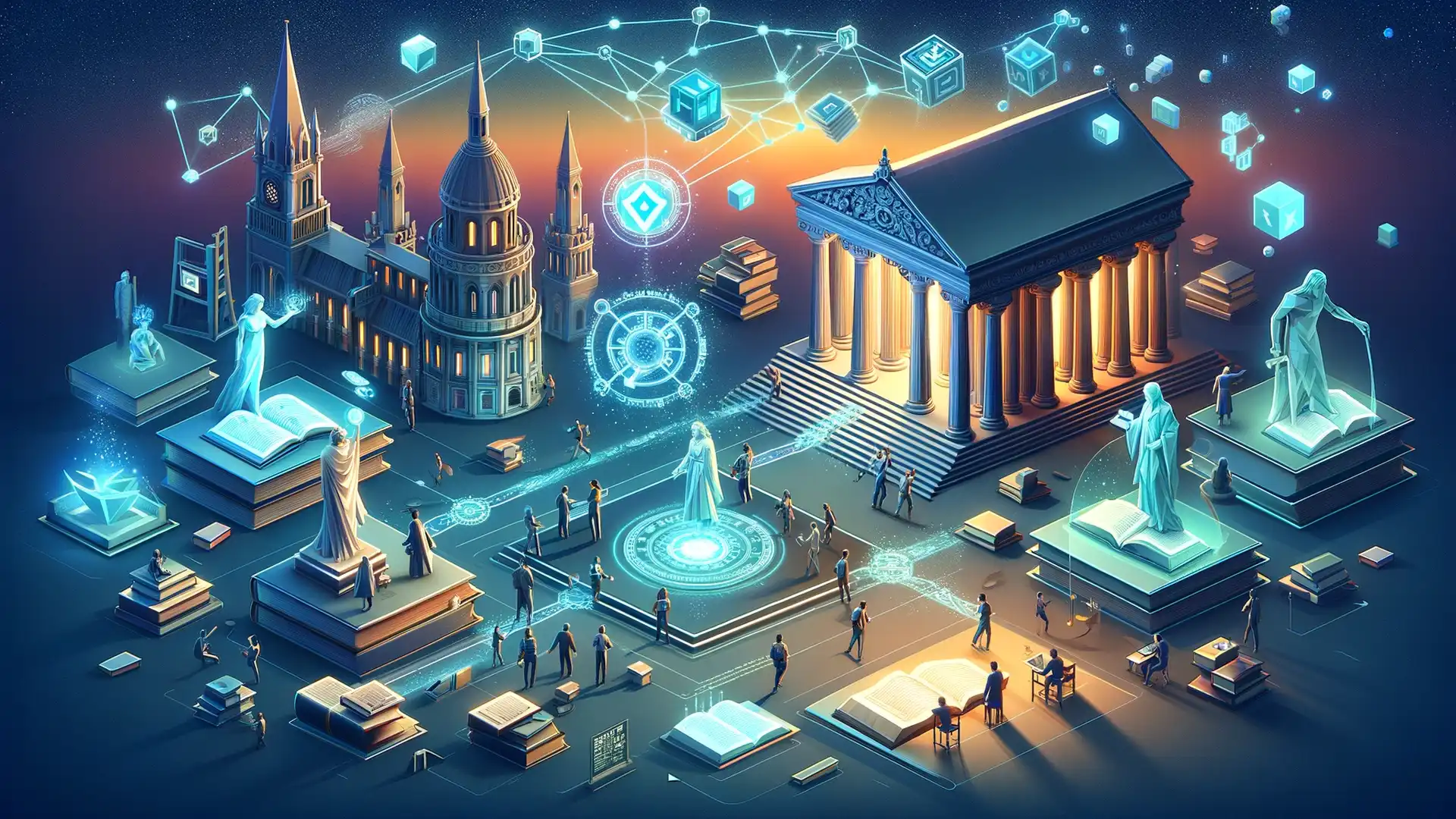NFT and Blockchain in Education: How are they used and why?

 Author:
Artem Grigoriev
Author:
Artem Grigoriev
Integrating NFTs and Blockchain in Education: Opportunities and Mechanisms
Embarking on a journey through the digital transformation of education , this chapter explores the dynamic intersection of Non-Fungible Tokens (NFTs) and blockchain technology within the educational sector. These advanced technologies are renowned for their security, transparency, and immutability. They serve as crucial tools that reshape how educational achievements and experiences are recorded and recognized.
📘 This article complements: "The Complete Guide to NFT Credentials". Explore it to find answers to all your questions;)
At its core, blockchain technology provides a decentralized record-keeping platform. It is distributed across multiple locations. This platform is ideally suited for managing educational credentials securely and transparently. By creating an immutable ledger of student achievements, blockchain acts as a formidable defense against fraud and misrepresentation. It reliably records everything from admission to graduation. This simplifies global verification of academic records without the risk of tampering.
The effectiveness of blockchain for these purposes is further highlighted by initiatives like Gartner’s research on blockchain . It predicts significant growth in its adoption across various sectors, including education, over the next decade.
NFTs introduce a fresh approach to education by serving as a medium to recognize and reward student achievements . For example, imagine a student receiving a unique digital token for excelling in a science fair or for community service. These tokens can act not only as a form of recognition but also as keys to unlock future educational resources or opportunities. This system not only motivates students but also makes their accomplishments verifiable and portable in a digital format.
As described in studies such as those published by the World Economic Forum , NFTs provide secure, indisputable records of ownership.
The integration of NFTs also includes the issuance of digital diplomas. This streamlines the verification process for employers and educational institutions. By using smart contracts —protocols that automatically execute, control, or document events and actions according to the terms of a contract or an agreement—educational institutions can automate the issuance and storage of these credentials. This ensures they are secure and easily accessible.
💡 Note: Blockchain's role in education extends beyond record-keeping. It also introduces innovative teaching methodologies. For instance, educators can create decentralized educational content that students can own or trade. This promotes a more engaged and personalized learning experience. It potentially shifts the educational landscape towards a more interactive and student-driven model. In this model, learning materials are not only consumed but are actively traded and updated by the students themselves.

Pioneering universities are beginning to adopt this technology to issue blockchain-based diplomas. This enhances the portability and verification speed of academic qualifications . A notable example of this innovation is seen at the Massachusetts Institute of Technology (MIT) , where MIT has experimented with blockchain to issue and verify certificates.
However, the path to integrating these technologies in education is fraught with challenges. The digital divide remains a significant barrier. It potentially widens gaps in educational equality due to disparities in access to technology. Resistance from traditional educational frameworks also poses a substantial challenge. This often stems from a lack of understanding or fear of the new technology's implications.
To overcome these obstacles, it is crucial to educate stakeholders about the benefits and potential of blockchain and NFTs in education . Implementing pilot projects can demonstrate tangible benefits and help ease the transition for skeptical educators and administrators. Showcasing successful models, like those reported by EdTech Review , can be particularly effective in demonstrating practical benefits and addressing concerns about scalability and integration.
The chapter concludes by considering the future landscape of education as influenced by blockchain and NFT technologies. It envisions an education system that is more decentralized, student-centered, and adaptable to the needs of a global and digital society. As these technologies mature, they promise to revolutionize how knowledge is acquired, certified, and shared. This paves the way for a new era of educational innovation.
💡 Tip: For educational institutions looking to integrate blockchain and NFTs, starting with small projects, such as digital badges for extracurricular achievements, can help manage the change progressively. This allows for adjustments and learning at each step. Engaging with and learning from early adopters can also provide valuable lessons and insights. This mitigates the risks associated with technology adoption and ensures a smoother integration into educational frameworks.

Overcoming Challenges and Exploring the Future of Blockchain and NFTs in Education
In this chapter, we delve into the complex task of implementing blockchain and NFT technologies within educational systems. We address both the challenges and potential benefits these innovations could bring. From privacy concerns to intellectual property management, the path to widespread adoption is laden with obstacles. These require careful navigation and thoughtful solutions.
A primary concern in using blockchain for educational purposes is privacy and security . The decentralized nature of blockchain offers enhanced security features. However, it also raises significant concerns about protecting sensitive student data . Blockchain's decentralization means that data is not stored in a single location but is distributed across multiple nodes (computers). This helps protect data from tampering or hacking.
To address these concerns, the chapter outlines strategies for integrating robust encryption and access controls. These comply with strict data protection laws like the GDPR in Europe and the CCPA in California. These measures ensure that student information remains secure and private, even when stored on a globally accessible ledger.
For additional guidance, resources like the International Association for Privacy Professionals (IAPP) provide best practices. They focus on privacy and data security in blockchain implementations, ensuring compliance with international regulations.
The intricacies of intellectual property (IP) in a blockchain environment also require attention. With educational content potentially becoming more decentralized, it is crucial to clarify copyright ownership and ensure fair compensation. The chapter discusses frameworks for effectively managing IP rights within a blockchain system. This ensures that educators and students maintain control over their creations and receive proper recognition and compensation for their contributions.
Contributions from legal experts at Stanford Law School’s Center for Internet and Society emphasize the need to adapt traditional IP laws. They accommodate the unique features of blockchain technology.
Addressing cultural and organizational resistance to these technologies, the chapter explores the skepticism often encountered when introducing blockchain and NFTs into traditional educational frameworks. It offers insights into overcoming these barriers by emphasizing the importance of fostering a technology-inclusive culture. It provides ongoing education about the benefits and workings of these technologies.
💡 Note: To facilitate adoption, educational leaders must not only advocate for the advantages of blockchain and NFTs but also actively participate in pilot projects and collaborations. This approach can create a more receptive environment, showcasing the practical impacts and operational efficiencies gained through these technologies.

Engaging with change management experts and utilizing case studies, such as those from the Harvard Business Review , can assist institutions in understanding and managing the transition to these new technologies more effectively.
Looking to the future, the potential for blockchain and NFTs to revolutionize education seems limitless. The chapter envisions scenarios where personalized learning experiences are enhanced by NFTs. This allows students to own, modify, and trade educational content that suits their individual learning styles and paces. This could lead to more flexible and student-driven educational pathways.
Blockchain ensures the secure management and verification of transactions and records. Thought leaders in educational technology, like those at EdTech Magazine , have explored these possibilities. They suggest how blockchain could enable more personalized and student-centered learning environments.
Another transformative trend is the decentralization of educational content . This could democratize access to learning materials and disrupt traditional educational hierarchies. The chapter describes potential decentralized platforms where individuals worldwide could contribute to and access a shared pool of knowledge without the need for central oversight.
This concept has been further discussed in publications by the Open Education Consortium . They advocate for open educational resources and the removal of barriers to education.
Case studies from pioneering institutions that have integrated blockchain and NFTs highlight the practical applications and benefits of these technologies. From enhancing student engagement through digital rewards to streamlining administrative processes with secure, transparent record-keeping, these examples provide valuable insights into both the potential and current realities of blockchain in education. Institutions like the University of Nicosia are often cited for their early adoption of blockchain for issuing and verifying academic credentials.
The chapter concludes by urging educators and policymakers to stay engaged with the development of blockchain and NFT technologies. By embracing these innovations, the educational sector can not only overcome current challenges but also move towards a more inclusive, efficient, and adaptable future.
💡 Tip: Educators looking to incorporate blockchain or NFTs should consider starting with small, controlled pilot programs. These allow for iterative learning and adjustments, thus paving the way for broader integration. Engaging with and understanding these technologies through practical applications can demystify the complexities. This demonstrates their potential in real-world educational settings and further facilitates widespread acceptance and implementation.

Integrating NFTs into Educational Platforms and LMS Systems
How to Verify the Authenticity of an NFT Credential and Identify the Owner
Securing NFT Credentials: Best Practices for Enhanced Safety
Decentralized Identity Verification Through NFT Credentials: What It Is and How It Works
Is Using NFT Credentials Legal? Legal Aspects and Privacy Concerns
